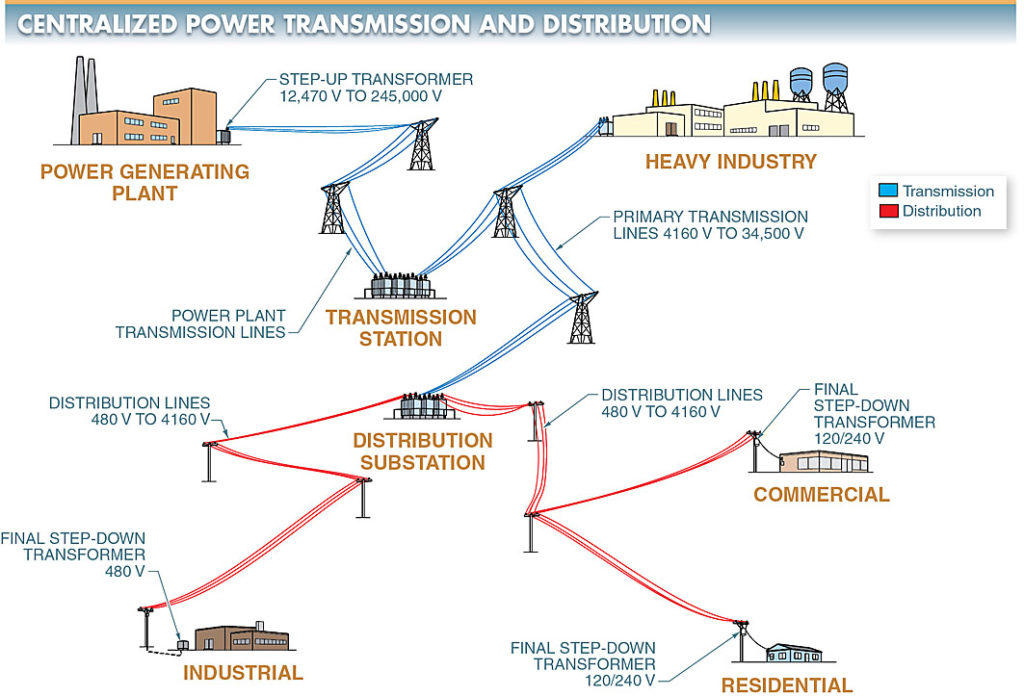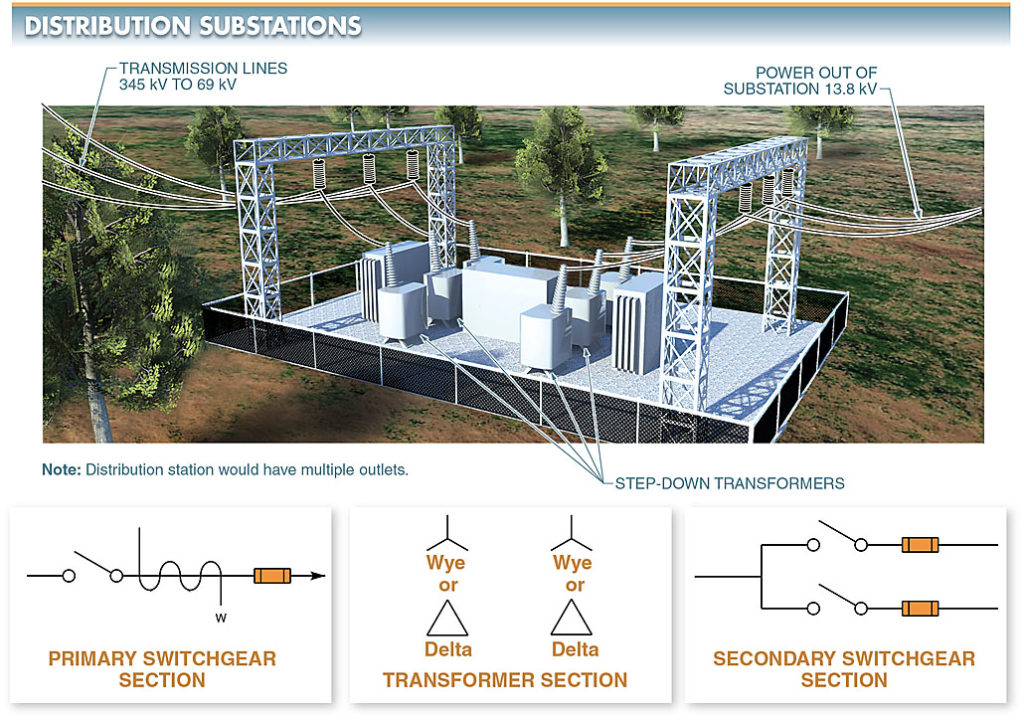Today, most electrical power is distributed through a network of transmission lines (conductors), substations (transformers), and generating equipment from relatively large, centralized power-generating stations directly to the customer.
These large, centralized power-generating stations are located near abundant energy sources such as coal, oil, and natural gas. Large, centralized power-generating stations are also located near natural resources. For example, nuclear power-generating stations are located near large sources of water to easily cool the reactor.
The electrical power created in a large, centralized power-generating station travels through many stages before it is used by loads.
The organization that produces and/or distributes electricity to customers is normally referred to as a utility.
However, the organizational structure of utilities has been changing as they divide their capabilities into separate business models such as electricity producers and electricity distributors.
Centralized Power Transmission and Distribution
Centralized power distribution is the process of delivering electrical power that is generated at a large centralized location to customers.
The power transmission and distribution system, from the power generation source to the customer’s loads, must be in good working order and properly maintained. See Figure 1.
Figure 1. An electric utility produces electricity at a centralized generating station and transmits and distributes it to industrial, commercial, and residential customers through power lines, substations, and transformers.
Power transmission is the process of delivering electrical power from a power-generating plant to a substation.
Power distribution is the process of delivering electrical power from a substation to the customer’s service-entrance equipment.
Power control, protection, transformation, transmission, distribution, and regulation must occur when electrical power is delivered to the customer. A centralized power transmission and distribution system commonly include the following parts:
- Step-up transformers—The generated voltage is stepped up to transmission voltage level. The transmission voltage level is normally between 12.47 kV and 245 kV.
- Generating station transmission lines —The 12.47 kV to 245 kV generating station transmission lines deliver power to the transmission substations.
- Transmission substations —The voltage is transformed to a lower primary (feeder) voltage. The primary voltage level is normally between 4.16 kV and 34.5 kV.
- Primary transmission lines—The 4.16 kV to 34.5 kV primary transmission lines deliver power to the distribution substations and heavy industry.
- Distribution substations —The voltage is transformed down to utilization voltages. Utilization voltage levels range from 480 V to 4.16 kV.
- Distribution lines—Power is carried from the distribution substation along the street or rear lot lines to the final step-down transformer.
- Final step-down transformers —Voltage is transformed to the required voltage, such as 480 V or 120/240 V. The final step-down transformers may be installed on poles, on-grade-level pads, or in underground vaults. The secondary of the final step-down transformer is connected to service-entrance cables that deliver power to service-entrance equipment. The number and size of transformers used to step down (reduce) the voltage before it is used by the customer’s power distribution system depends on the customer’s power requirements.
Transmission Lines and Towers
A transmission line is a conductor that carries large amounts of electrical power at high voltages over long distances. See Figure 2. Aerial transmission lines must be spaced far enough apart and elevated in order to be safe.
Very Important
The transmission voltage level varies depending on the required transmission distance and amount of power carried. The longer the distance or higher the transmitted power, the higher the transmitted voltage.
Annual electricity transmission and distribution losses may result in losses as much as 6% to 7% of the generated electrical power, mostly attributed to heat.
Transmission line voltages can vary from a few kilovolts to hundreds of kilovolts. Transmission-line conductor sizes are based on the amount of current they can safely carry without overheating.
For a given power level, the amount of current varies inversely with the amount of voltage. See Figure 3. Increasing the transmitted voltage reduces the power losses between the utility and the customer.
Power loss can be reduced up to 75% when the transmitted voltage is doubled. When power is transmitted at high voltages, the required size and weight of the conductors is reduced. Therefore, higher transmitted voltages allow for reduced conductor size, allow more power to be transmitted, and result in a lower material cost.
Figure 2. Transmission lines safely carry large amounts of electrical power at high voltages over long distances.
Figure 3. For a given power level, the amount of current varies inversely with the amount of voltage.
Distribution Substations
Definition: A distribution substation is an outdoor facility located close to the point of electrical service use and is used for changing voltage levels, providing a central place for system switching, monitoring protection, and redistributing power.
Distribution substations take high transmitted voltages and reduce the voltage for appropriate distribution levels. Distribution substations normally operate at lower voltages than transmission substations. Distribution substation output voltages are normally between 12 kV and 13.8 kV. See Figure 4.
Distribution substations serve as a source of voltage transformation and control along the distribution system. Distribution substations include the following functions:
- receiving voltage generated and adjusting it to a level appropriate for further transmission or customer use
- providing a switching point where different connections may be made
- providing a safe point in the distribution grid for disconnecting the power in the event of a problem
- providing a convenient place to take measurements and check the operation of the distribution system
Figure 4. Distribution substations provide a convenient place along the distribution system for maintenance, checks, and fine adjustments.
Tech Fact
The highest current at which a power line can be operated is called the transmission line real-time rating. Transmission line real-time ratings are based on wind speed, ambient temperature, and solar radiation. This rating determines the maximum current that can be transmitted without violating safety codes, decreasing network reliability, or damaging equipment. When the live current exceeds this rating, the conductors heat, causing the line to sag and increase in resistance.
Distribution Substation Components
Distribution substations have three main components: primary switchgear, transformer, and secondary switchgear.
Depending on the function of the substation, the primary or secondary switchgear may be the high-voltage or low-voltage section.
In step-up substations, the primary switchgear is the low-voltage section and the secondary switchgear is the high- voltage section.
In step-down substations, the primary switchgear is the high-voltage section and the secondary switchgear is the low-voltage section.
The components of a distribution substation also normally include circuit breakers and interrupter switches.
Power Distribution to Point of Use
Electrical power is delivered to residential, commercial, and industrial buildings through distribution lines. See Figure 5. These distribution lines are terminated at commercial and industrial buildings through switchboards.
Switchboards are high-power electrical equipment that switches and divider circuits in the building distribution system.
Switchboards may contain a panel or an assembly of panels containing electrical switches, meters, and overcurrent protective devices (OCPDs).
Once power is delivered to a building, switchboards further distribute the power to where it is required within the building. The power for residential customers is generally terminated and distributed through a panelboard.
Figure 5. Power is fed through circuit breakers in the panelboard and routed through cables or busways to power distribution panels to the points of use.
The electrical service provided by a utility may be overheard or lateral.
Overhead service is an electrical service in which service-entrance conductors are run through the air from the utility pole to the building.
Service lateral is an electrical service in which service-entrance conductors are run underground from the utility system to the service point.
A service point is the point of connection between the facilities of the utility and the premises wiring. Typically, the switchboard is the last point on the power distribution system from the utility company and the beginning of most building power distribution systems.






